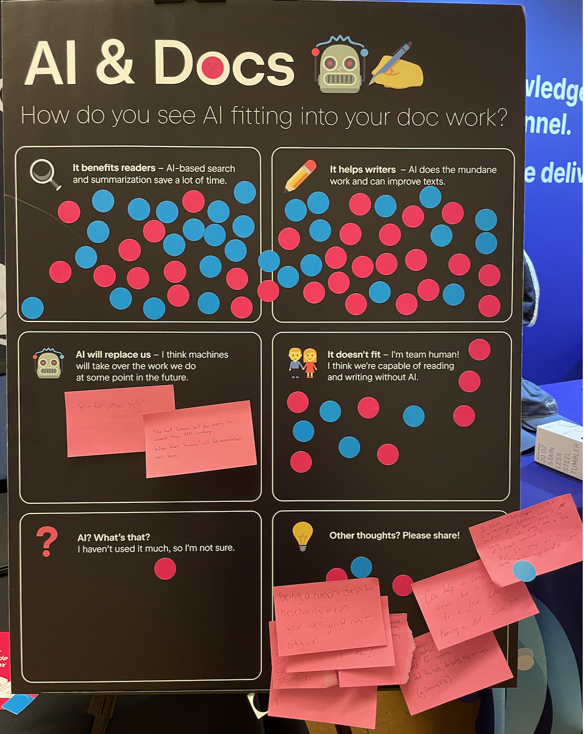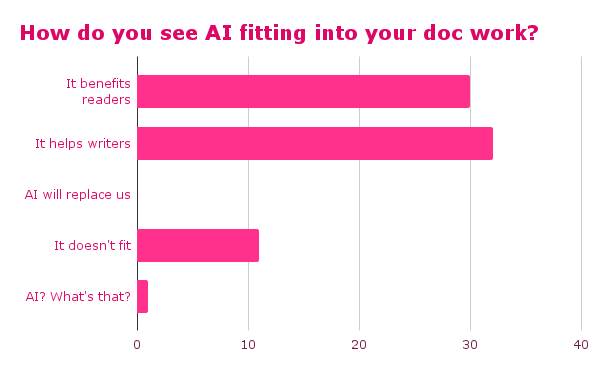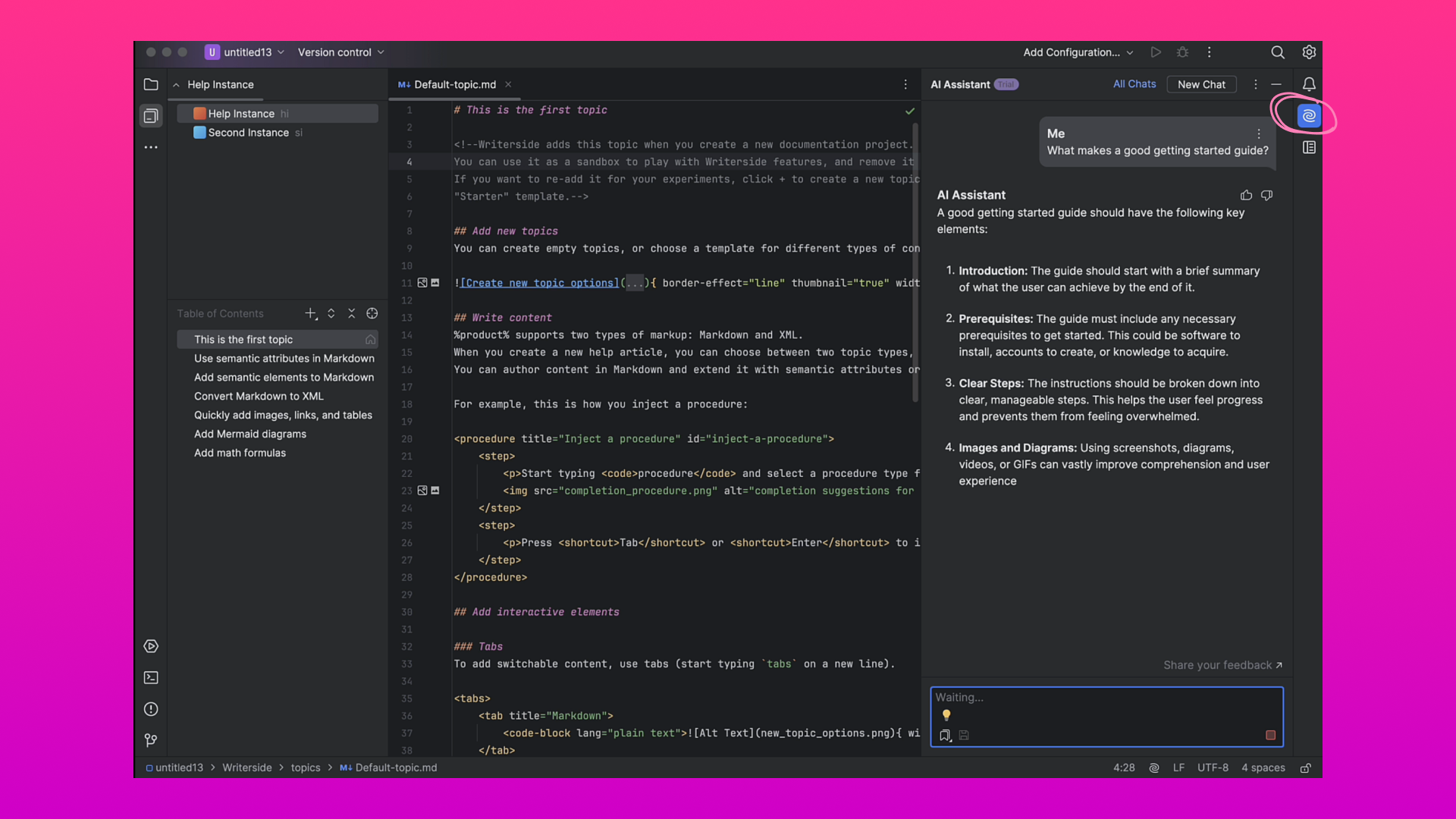On Writer's Side
Intelligent tools for writers and new ways to write better
Writerside’s First AI EAP Release is Out
The first Writerside build with AI-powered features is now available as part of its Early Access Program.
Read on the full story, or jump straight to the new features.
No longer a threat, AI is a writer’s friend
Just one year ago, tech writers felt threatened by the AI breakthrough and were worried their jobs were in jeopardy. In Tom Johnson’s survey on how AI will impact tech writing, almost 80% of respondents expressed some degree of concern.
But the sentiment has now changed, and just over one year later, tech writers are learning to use AI to accelerate their work and they are looking into how they can incorporate it into their day-to-day routines.
Our survey findings
We ran our own small interactive survey at Write the Docs Portland in April 2024, and it looks like no one really thinks AI will take their job anymore:


The only two comments associated with “AI will replace us” were more humorous in nature:
“The last human will be born sometime around the 28th century. After that, humans will be assembled, not born”.
Here are some takeaways from our discussions, as well as some of the thoughts our fellow documentarians shared with us:
- The phrase “I want to delegate routine tasks” popped up many times. Documentarians regularly have to cope with large amounts of unstructured information, including numerous discussions with SMEs via Slack, issues in an issue tracker, comments in code reviews and pull requests, and internal docs. AI could analyze these sources of content, understand the context, identify key insights, and extract actionable information.
- We had a few fruitful discussions about intellectual property and the legal intricacies around AI-produced content. Who owns the content if AI was used to proofread, rewrite, or restructure it? Whether and how should we, as authors and content owners, notify our users that AI was involved? Who is responsible for incorrect answers or hallucinations produced by AI?
- Many respondents expressed concerns about relying on AI algorithms in serious matters and said they need to double-check, if not triple-check, the information it produces.
- A few people were quite optimistic about the role of semantic and structural authoring in an AI-first world, telling us that we have been preparing our docs for AI for years already using various semantic markup languages and taxonomies, which makes content easier for AI to digest.
What can doc authors outsource to AI?

Our take on AI at Writerside – outsource routine work to the machines, and leave creativity to humans! Our internal discussions and the survey both show that writers hope AI will spare them from repetitive mundane tasks and enhance their review procedures.
So what jobs would content authors delegate to AI?
The things writers don’t love producing so much
- Text meant for robots: like SEO metadata, etc.
- Non-creative writing: summaries, TLDRs, term definitions, and indexes.
- Non-text documentation assets: diagrams, code samples, augmented screenshots, etc.
- Style-guide imposed checks: writers prefer these to be automated – it feels much less awkward than when your errors are caught by a human editor.
The work developers don’t love so much
- Starting to write: staring at a blank page with no idea where to start or how to structure content.
- Improving text: reorganizing, simplifying text, or changing the tone of voice.
- Learning new markup: wrapping content into semantic elements (like tabs, tables, or collapsible blocks) and performing consistency checks.
- Checking grammar or even translating.
But wait! Aren’t there readers? How can AI improve their experience?
As you can see from our survey board, writers don’t want AI simply for their own sake. They can see just as well how their readers could benefit from AI-based features, such as:
- Flexible search functionality that would actually provide answers to questions, ideally in the search query language, instead of simply returning links to other pages.
- Additional explanations when docs aren’t enough, like explanations of code samples, suggestions for related resources outside the documentation, or even the conversion of content into a different format, such as an audio clip or a diagram.
- On-the-fly translation of content in the browsers.
Writerside’s first AI-based features
The new version of Writerside comes with:
- Integrated JetBrains AI Assistant, which lets you chat with AI to accelerate your work without leaving your writing environment.

- Context-aware actions for adjusting text: Use Opt+Enter | AI Actions to rephrase, re-write, or translate selected text.
- AI-based content generation: Use Opt+Enter | AI Actions to generate a TLRD, a <web-summary/> tag with metadata for SEO, or a link summary.
How to try AI in Writerside
To use the AI-based features in Writerside, you need to install the JetBrains AI Assistant plugin and activate a license. If you are already using the AI Assistant in other JetBrains IDEs, there’s no need to obtain a separate AI license for Writerside – you only pay once.
Your free trial of AI Assistant will last for 7 days. After your trial license expires, you will need to obtain a paid license.
For instructions on how to setup AI Assistant in Writerside, refer to our docs.
What comes next?
These are just our first steps toward harnessing the power of AI for writers, and of course, we have a handful of other AI-based features on the way, including:
- Automation of style guide checks
- Generating doc structure, or giving structure to a wall of text
- Generating descriptions for terms and glossary indexes
- Generating code samples
- And much more
What’s your big idea – what should we add to our AI toolset?
Now that you’ve tried Writerside and know about our AI-related plans, do you think it will make authoring documentation easier for you?
Share your knowledge and expertise with us – let’s talk!




